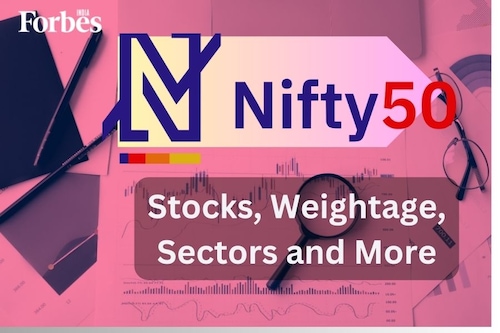Nifty 50 stocks list in 2025: Stock weightage, sectors and computation methodolo
Explore the Nifty 50 stocks on the National Stock Exchange (NSE) list. Build a strong portfolio with these blue-chip gems


The Nifty 50 index holds significant importance within the National Stock Exchange (NSE) as a well-diversified index representing 50 carefully selected companies, providing insights into overall market conditions. Nifty’s value is calculated using the capitalisation method of free float. The index encompasses various sectors such as Financial Services, IT, FMCG, power, oil and gas, metal, construction, automobiles, chemicals, and so on.
The Nifty 50 is a crucial stock market index comprising the 50 largest publicly traded companies listed on the NSE in India. It is widely regarded as a reliable gauge of the Indian equity market, measuring the broader market"s performance. The index follows a methodology that weighs its constituents based on free-float market capitalisation, thereby reflecting the total market value of the stocks relative to a specific base period. Acting as a benchmark index, the Nifty 50 plays a fundamental role for investors, serving as a reference point for index and exchange-traded funds.
Nifty Options and Futures trading is popular among traders in India, with Foreign Institutional Investors (FII) and Domestic Institutional Investors (DII) actively participating in Nifty trading. Nifty Options Trading expires every Thursday, offering traders opportunities to engage in derivatives trading strategies. Notable stocks within the Nifty 50 index include HDFC Bank, Reliance, TCS, ICICI Bank, SBI, and Larsen & Toubro Ltd., making significant contributions to the overall index performance.
From industry giants to emerging powerhouses, we will explore the key players shaping India"s economy and driving its growth. The Nifty 50 index, comprising the top 50 actively traded stocks on India"s National Stock Exchange (NSE), is a barometer of the country"s economic health and investor sentiment. The weightage and constituents data are as of January 31, 2025, sourced from NSE India.
| Name | Weightage |
|---|---|
| HDFC Bank Ltd | 12.24% |
| ICICI Bank Ltd. | 8.38% |
| Reliance Industries Ltd | 8.14% |
| Infosys Limited | 6.42% |
| Bharti Airtel Limited | 4.13% |
| Tata Consultancy Services Ltd | 3.98% |
| Larsen & Toubro Ltd. | 3.98% |
| ITC Ltd | 3.94% |
| State Bank of India | 2.82% |
| Axis Bank Limited | 2.66% |
| Kotak Mahindra Bank Ltd | 2.65% |
| Mahindra & Mahindra Ltd | 2.51% |
| Bajaj Finance Limited | 2.09% |
| Hindustan Unilever Ltd. | 2.08% |
| Sun Pharmaceutical Industries Ltd | 1.78% |
| HCL Technologies Ltd | 1.73% |
| Maruti Suzuki India Ltd. | 1.53% |
| NTPC Ltd | 1.45% |
| Tata Motors Limited | 1.42% |
| Titan Company Limited | 1.37% |
| Power Grid Corporation of India Ltd | 1.29% |
| UltraTech Cement Limited | 1.24% |
| Trent Ltd | 1.21% |
| Tata Steel Limited | 1.06% |
| Tech Mahindra Limited | 1.01% |
| Bharat Electronics Ltd | 0.99% |
| Asian Paints Limited | 0.99% |
| Oil and Natural Gas Corporation | 0.97% |
| ITC Hotels Limited | 0.14% |
Understanding the breakdown of weightage among different sectors offers valuable insights into the overall composition and performance of the market. By exploring the weightage distribution, investors and analysts can better understand the sectors that wield significant influence, enabling them to make informed decisions and capitalise on emerging opportunities.
| Sector | Weight (%) |
|---|---|
| Financial Services | 34.35 |
| Information Technology | 13.97 |
| Oil, Gas & Consumable Fuels | 10.43 |
| Fast Moving Consumer Goods | 8.01 |
| Automobile and Auto Components | 7.61 |
| Telecommunication | 4.13 |
| Construction | 3.98 |
| Healthcare | 3.91 |
| Metals & Mining | 3.27 |
| Power | 2.75 |
| Consumer Durables | 2.35 |
| Construction Materials | 2.12 |
| Consumer Services | 1.35 |
| Capital Goods | 0.99 |
| Services | 0.77 |
The Nifty 50 index is computed using the free float market capitalisation-weighted method. Here"s a simplified explanation of how it works:
1. What is Nifty?
The term "Nifty" refers to a stock market index established by the National Stock Exchange (NSE). It derives its name from "NSE Fifty," indicating the inclusion of the top 50 stocks listed on the NSE. For a comprehensive understanding of the companies encompassed within this index, interested individuals can refer to the designated web page for further details.
2. How to buy/invest in Nifty 50?
To invest in Nifty 50 , individuals can buy index funds or exchange-traded funds (ETFs) that track the performance of the Nifty 50 index. These funds can be purchased through a stockbroker or online trading platforms, providing exposure to the 50 major stocks listed on the National Stock Exchange of India.
3. How is Nifty 50 different from the Sensex?
While both Nifty 50 and Sensex are stock market indices in India, they differ in their composition. Nifty 50 represents the top 50 stocks listed on the NSE, whereas the Sensex represents the 30 stocks listed on the Bombay Stock Exchange (BSE). The selection criteria and weighting methodology are also different for these indices.
First Published: Feb 19, 2025, 09:20
Subscribe Now